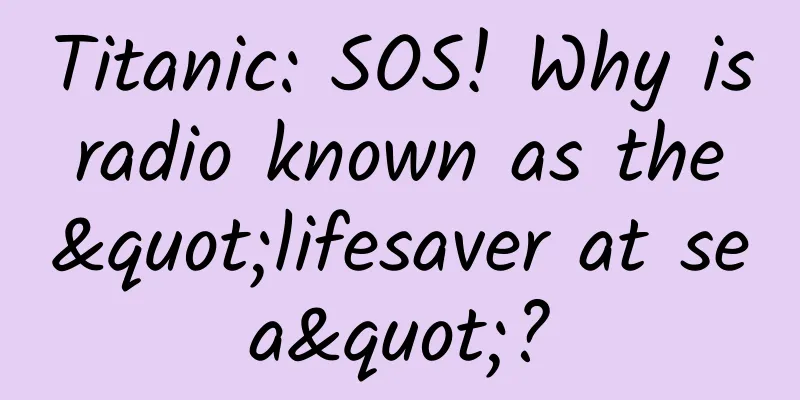Titanic: SOS! Why is radio known as the "lifesaver at sea"?

|
Ancient sea-going ships How do you exchange information with your home port thousands of miles away? The "Supplement to the History of the Tang Dynasty" compiled by Li Zhao in the Tang Dynasty recorded that the "Nanhai ships" that came to Guangzhou for trade at that time "must raise white pigeons as a signal on the sea route. If the ship sank, the pigeons would be able to return even if they were thousands of miles away." "New Book of the Southern Region" written by Qian Yi in the Song Dynasty also said: "Many Persian ships raise pigeons. When the pigeons fly thousands of miles, they would release one to their home as a signal of safety." However, "carrier pigeons" were only one-way communication from the ship to the land. Carrier pigeons could not transmit messages from the land to the ship at sea. At the end of the 19th century, Marconi of Italy and Popov of Russia invented radio communication. This invention originated in 1885, when the 27-year-old German physics professor Hertz discovered during a spark discharge experiment that whenever a discharge coil produced a spark, a small spark would also appear at both ends of another coil several meters away. However, Hertz did not explore further, as he thought it was just an interesting phenomenon and had no use. Nine years later, Marconi, a 20-year-old Italian boy, learned about this and was sensitive to the fact that it was possible to use this electromagnetic induction phenomenon to send signals over long distances. At that time, wired telegraphs had already appeared, but Marconi thought of communicating without wires, such as exchanging information with ships at sea. ▲ British stamps commemorating Marconi (Pictures from the Internet) Marconi was an excellent experimentalist and a DIY expert. After a year of hard work, he successfully trial-produced a device that used electromagnetic waves to transmit and receive information, and made a public demonstration in the UK, obtaining the first patent for radio invention. In 1899, he achieved radio wave communication across the English Channel. In 1901, the radio signal transmitted by Marconi crossed the Atlantic Ocean from England to Newfoundland, Canada. Radio communication changed the human world, and Marconi won the 1909 Nobel Prize in Physics for this. ▲ Marconi's radio experimental device (left) The earliest radio transmitter and receiver (right) (Pictures from the Internet) Marconi's invention was used in the field of navigation as soon as it came out. In 1899, a beacon ship equipped with a Marconi transmitter was overturned by a tugboat off the coast of Britain. It sent out a distress signal by radio in time, and the lifeboat rushed to rescue the crew members in distress. People saw the huge potential value of radio from this incident. In 1906, the first International Wireless Telegraph Conference was held in Berlin, with 29 countries participating and signing the International Radio Convention. It was at that conference that the distress signal at sea was stipulated to be "SOS", but this resolution was not generally accepted and followed. On April 14, 1912, the super cruise ship Titanic made its maiden voyage in the Atlantic Ocean. There were two radio operators on board, one named Jack Phillips and the other was Phillips' deputy Bullid. At that time, more than one ship warned the Titanic that there was an iceberg nearby. But the Titanic's radio operator was busy sending private telegrams to VIP guests and ignored these alarms. That night, the Titanic hit an iceberg and the hull was flooded. Bullid then used a telegraph key to type out the distress signal "CQD MGY", which was an outdated distress signal before the international establishment of SOS. In fact, there was a ship not far from the Titanic, but at that time the radio station was not required to be on duty continuously, and the radio operator of the ship had turned off the radio and went to sleep. ▲ Titanic's distress signal (Pictures from the Internet) Farther out at sea, there was another ship, the Carpathia. Its radio operator, Cottom, was also preparing to rest, but insisted on listening for a while before shutting down. At this moment, the Titanic's radio operator, Phillips, began to send an SOS call for help. So Cottom of the Carpathia received the following telegram: "We have hit an iceberg and are sinking rapidly. Come to rescue as soon as possible." The Titanic was sinking rapidly, but the radio operator continued to call for help very diligently. When it was about to sink, the captain asked the two radio operators to abandon the ship and escape, but Phillips stayed at his post and sent radio calls until the last moment. He eventually sank to the bottom of the sea with the ship. Assistant radio operator Bullid survived by chance. Thanks to their efforts, the "Carpathia" heard the news and rushed to the Titanic. When it arrived, the Titanic had already sunk. About 700 survivors floating on the sea were rescued by the "Carpathia". Afterwards, the British newspaper The Times commented: "We are grateful to Marconi for inventing a device that enabled the Titanic to send out the news of the accident and distress signals as quickly as possible. Before this, many luxurious ships sank without sending out distress signals." One year after the Titanic disaster, an international conference on the safety of life at sea was held in London, stipulating that ships over 5,000 tons must be equipped with radio transceivers, with someone on duty 24 hours a day, and a special channel designated. A special marine clock is set up in the radio room, with two red and two blue radio silent periods on the clock face. All ship radio operators must stop general communication business during these periods and quietly listen to the special emergency call frequency. Today, many advanced ships have eliminated radio rooms and no longer have dedicated radio operators. Crew members can send and receive information through maritime satellite communication systems, just as conveniently as making phone calls and surfing the Internet at home. ▲ Marine distress radio beacon (Collection of China Maritime Museum) At the end of the 20th century, the famous SOS maritime distress call system also retired gloriously and was replaced by the faster and more reliable "Global Maritime Distress and Safety System" (GMDSS), which includes modern information technologies such as satellite communications and digital selective calling. When a ship is in distress, it no longer needs to send an SOS manually, but automatically calls for help; there is also an automatic beacon on the ship, which will automatically call for help once it falls into the sea. The satellite in the sky receives the signal at the first time, immediately locates the distressed ship, and automatically forwards it to the nearest maritime department for rescue. The information transmission carrier of GMDSS is still radio waves. ▲ Marine radio direction finding antenna (Collection of China Maritime Museum) |
>>: Why does the whole camellia fall to the ground when it "closes its curtain"?
Recommend
Is neck wrinkle cream really effective? A 45-day comparison of the results...
Some people say that the neck is a woman’s second...
Good Method Classroom Wang Fang Knows the Earth (Intermediate)
Good Method Classroom Wang Fang Knowing the Earth...
How to quickly increase followers on Weibo? Tips for increasing followers on Weibo!
How can Weibo operators increase followers quickl...
Japanese manufacturing scandals continue: How can Chinese home appliance companies break out?
Once upon a time, Japanese manufacturing was syno...
Another virus that infects humans and animals has been discovered. Can it be transmitted from person to person?
Recently, Professor Liu Wei, Professor Fang Liqun...
Product activity operation and promotion planning plan!
Activities are a very important way to quickly at...
If eaten improperly, spring bamboo shoots may turn into "spring damage"! Read quickly →
Every February and March is the time when bamboo ...
Google executives express willingness to return to the Chinese market
According to foreign media reports, Google Senior...
4K HDR+ massive resources to see how PPTV P1 box brings you a new big-screen TV experience
After 4K resolution became popular on TVs, the HD...
Volkswagen expands cooperation with Nvidia to cover more areas besides automobiles
According to foreign media reports, the German Vol...
Case | Investment and franchise advertising cases and effect data!
Today I will share with you an optimization case ...
Exploring the Secrets of World Navigation丨Western "Latitude and Longitude Positioning" Navigation Technique
Sailed with Columbus and Magellan Travel through ...
How does Uber solve the identity problem in the United States?
Today we will not talk about Hangzhou, but how Ub...
Jianou SEO training: How to do enterprise SEO promotion? What methods can be used?
In today's society, business operations canno...
It’s no good having everything. Born with a silver spoon in their mouth but rolling in the mud, when will the second generation of startups like Lantu, Zhiji, and Avita be able to make a comeback?
At the beginning of July, all major new energy ma...









